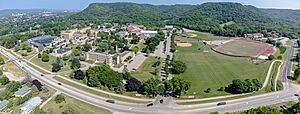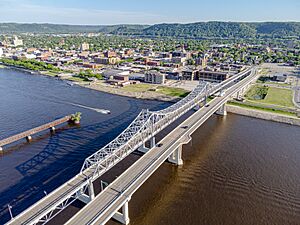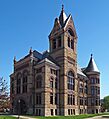Winona, Minnesota facts for kids
Quick facts for kids
Winona, Minnesota
|
|
|---|---|
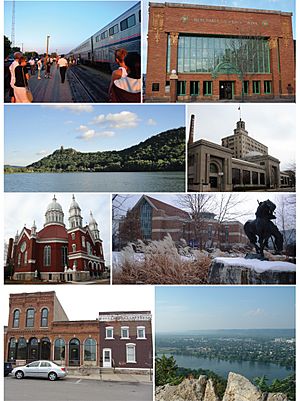
Left-to-right from top-left: the Empire Builder at Winona station, Merchants National Bank, Sugar Loaf, Watkins Incorporated, Basilica of St. Stanislaus, Krueger Library, East Second Street Historic Commercial District, and Garvin Heights City Park.
|
|
| Nickname(s):
The Island City
|
|

|
|
| Country | United States |
| State | Minnesota |
| County | Winona |
| Founded | 1851 |
| Incorporated | March 6, 1857 |
| Government | |
| • Type | Mayor - Council |
| Area | |
| • Total | 24.32 sq mi (62.98 km2) |
| • Land | 19.03 sq mi (49.29 km2) |
| • Water | 5.29 sq mi (13.70 km2) |
| Elevation | 659 ft (201 m) |
| Population
(2020)
|
|
| • Total | 25,948 |
| • Estimate
(2022)
|
25,842 |
| • Density | 1,363.53/sq mi (526.46/km2) |
| Time zone | UTC–6 (Central (CST)) |
| • Summer (DST) | UTC–5 (CDT) |
| ZIP code |
55987
|
| Area code(s) | 507 |
| FIPS code | 27-71032 |
| GNIS feature ID | 2397348 |
Winona is a city in Minnesota, United States. It is the main city of Winona County, Minnesota. Winona is located in a beautiful area with bluffs along the Mississippi River. Its most famous landmark is Sugar Loaf, a unique rock formation. In 2020, about 25,948 people lived in Winona.
Contents
History of Winona
The area where Winona now stands was once home to the Dakota people. Their village was called Keoxa. The city of Winona gets its name from a Sioux legend about a figure named Winona.
Early Settlers and Growth
European immigrants started settling here in 1851. They began planning the town in 1852 and 1853. Many of the first settlers came from New England. The city grew very quickly. By December 1855, there were 815 people, and by December 1856, there were 3,000!
In 1856, German immigrants also arrived. These German settlers and the earlier American settlers worked together. They planted trees and built businesses. These businesses focused on lumber, wheat, and river travel using steamboats.
Polish and Kashubian Influence
Between 1859 and 1900, about 5,000 Poles and Kashubians moved to Winona. Kashubians are a group closely related to Poles. They made up a quarter of the city's population. Because so many Kashubians settled here, Winona became known as the "Kashubian Capital of America." The large number of Polish Catholic immigrants led to the building of the Church of St. Stanislaus. This church is now known as the Basilica of St. Stanislaus Kostka.
Transportation and Development
Winona grew a lot thanks to railroads and steamboats. These transportation methods helped the city develop industries like wheat milling and lumber production. In 1856, over 1,300 steamboats stopped in Winona.
The Winona and St. Peter Railroad was one of Minnesota's first railroads. Its first section, about 11 miles long, was finished by the end of 1862. In 1870, a railroad bridge was built across the Mississippi River at Winona. Later, in 1892, a toll bridge for wagons was also completed. This bridge was used until 1942.
Winona has two historic areas listed on the National Register of Historic Places. These areas are protected and managed by the city. A special outdoor stage called a bandshell was built in 1924. The Winona Municipal Band still holds concerts there in the summer.
Geography of Winona
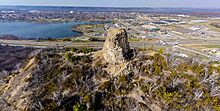
Winona covers about 24.32 square miles. Most of this is land, but about 5.29 square miles is water. A lock and dam system, called Lock and Dam 5A, crosses the Mississippi River in Winona. A highway bridge connects Winona to the Wisconsin side of the river.
Nearby Towns and Cities
Winona has several smaller towns nearby. These include Goodview, Stockton, Minnesota City, and Rollingstone to the west. To the southeast is Homer. Across the river in Wisconsin are Bluff Siding and Fountain City. Larger cities like Rochester (44 miles west) and La Crosse (30 miles southeast) are also close by.
Driftless Area and Latsch Island
Winona is part of the "Driftless Area". This is a unique region that was not covered by ice during the last ice age. It includes parts of Minnesota, Iowa, Wisconsin, and Illinois.
Just northeast of Winona is Latsch Island. It is connected to the city by bridges. Since 1998, Latsch Island has been officially part of Winona. It is known for its special community of people who live in houseboats, often called "Boathouse" residents.
Winona's Climate
Winona has one of the warmest climates in Minnesota. The average temperature for the whole year is about 48.9 degrees Fahrenheit. In January, the average temperature is around 17.6 degrees Fahrenheit. In July, it's about 75.8 degrees Fahrenheit. Winona has a humid continental climate. This means it has hot, humid summers and cold, snowy winters.
| Climate data for Winona Dam 5 A, Minnesota (1991–2020 normals, extremes 1893–present) | |||||||||||||
|---|---|---|---|---|---|---|---|---|---|---|---|---|---|
| Month | Jan | Feb | Mar | Apr | May | Jun | Jul | Aug | Sep | Oct | Nov | Dec | Year |
| Record high °F (°C) | 64 (18) |
73 (23) |
88 (31) |
96 (36) |
107 (42) |
106 (41) |
108 (42) |
103 (39) |
102 (39) |
93 (34) |
84 (29) |
66 (19) |
108 (42) |
| Mean maximum °F (°C) | 44.8 (7.1) |
50.2 (10.1) |
65.8 (18.8) |
78.9 (26.1) |
86.9 (30.5) |
92.4 (33.6) |
93.6 (34.2) |
92.0 (33.3) |
87.9 (31.1) |
81.4 (27.4) |
64.1 (17.8) |
49.9 (9.9) |
95.7 (35.4) |
| Mean daily maximum °F (°C) | 25.0 (−3.9) |
30.2 (−1.0) |
42.3 (5.7) |
56.4 (13.6) |
68.7 (20.4) |
78.4 (25.8) |
82.5 (28.1) |
80.6 (27.0) |
73.2 (22.9) |
59.4 (15.2) |
43.5 (6.4) |
30.7 (−0.7) |
55.9 (13.3) |
| Daily mean °F (°C) | 16.5 (−8.6) |
20.7 (−6.3) |
33.0 (0.6) |
46.5 (8.1) |
58.4 (14.7) |
68.5 (20.3) |
72.8 (22.7) |
71.0 (21.7) |
63.4 (17.4) |
50.4 (10.2) |
36.3 (2.4) |
23.5 (−4.7) |
46.7 (8.2) |
| Mean daily minimum °F (°C) | 8.0 (−13.3) |
11.1 (−11.6) |
23.8 (−4.6) |
36.5 (2.5) |
48.0 (8.9) |
58.6 (14.8) |
63.0 (17.2) |
61.4 (16.3) |
53.6 (12.0) |
41.4 (5.2) |
29.2 (−1.6) |
16.3 (−8.7) |
37.6 (3.1) |
| Mean minimum °F (°C) | −15.3 (−26.3) |
−12.1 (−24.5) |
1.3 (−17.1) |
23.4 (−4.8) |
36.0 (2.2) |
46.5 (8.1) |
54.1 (12.3) |
52.3 (11.3) |
40.5 (4.7) |
27.8 (−2.3) |
13.2 (−10.4) |
−6.1 (−21.2) |
−18.9 (−28.3) |
| Record low °F (°C) | −35 (−37) |
−38 (−39) |
−28 (−33) |
4 (−16) |
21 (−6) |
35 (2) |
43 (6) |
33 (1) |
25 (−4) |
7 (−14) |
−11 (−24) |
−31 (−35) |
−38 (−39) |
| Average precipitation inches (mm) | 1.06 (27) |
1.02 (26) |
1.91 (49) |
3.65 (93) |
4.14 (105) |
4.83 (123) |
4.11 (104) |
4.55 (116) |
3.57 (91) |
2.53 (64) |
1.85 (47) |
1.22 (31) |
34.44 (875) |
| Average snowfall inches (cm) | 9.8 (25) |
9.3 (24) |
5.7 (14) |
1.6 (4.1) |
0.2 (0.51) |
0.0 (0.0) |
0.0 (0.0) |
0.0 (0.0) |
0.0 (0.0) |
0.1 (0.25) |
1.4 (3.6) |
9.5 (24) |
37.6 (96) |
| Average extreme snow depth inches (cm) | 9.6 (24) |
11.4 (29) |
7.7 (20) |
1.1 (2.8) |
0.2 (0.51) |
0.0 (0.0) |
0.0 (0.0) |
0.0 (0.0) |
0.0 (0.0) |
0.0 (0.0) |
1.0 (2.5) |
7.1 (18) |
14.1 (36) |
| Average precipitation days (≥ 0.01 in) | 8.6 | 7.6 | 9.0 | 11.8 | 13.0 | 12.2 | 10.1 | 9.4 | 9.5 | 9.6 | 7.5 | 9.0 | 117.3 |
| Average snowy days (≥ 0.1 in) | 5.3 | 4.4 | 2.3 | 0.7 | 0.0 | 0.0 | 0.0 | 0.0 | 0.0 | 0.1 | 1.1 | 4.7 | 18.6 |
| Source: NOAA | |||||||||||||
People of Winona
| Historical population | |||
|---|---|---|---|
| Census | Pop. | %± | |
| 1860 | 2,464 | — | |
| 1870 | 7,192 | 191.9% | |
| 1880 | 10,208 | 41.9% | |
| 1890 | 18,208 | 78.4% | |
| 1900 | 19,714 | 8.3% | |
| 1910 | 18,583 | −5.7% | |
| 1920 | 19,143 | 3.0% | |
| 1930 | 20,850 | 8.9% | |
| 1940 | 22,490 | 7.9% | |
| 1950 | 25,031 | 11.3% | |
| 1960 | 24,895 | −0.5% | |
| 1970 | 26,438 | 6.2% | |
| 1980 | 25,075 | −5.2% | |
| 1990 | 25,399 | 1.3% | |
| 2000 | 27,069 | 6.6% | |
| 2010 | 27,592 | 1.9% | |
| 2020 | 25,948 | −6.0% | |
| 2022 (est.) | 25,842 | −6.3% | |
| U.S. Decennial Census 2020 Census |
|||
Population in 2020
In 2020, Winona had a population of 25,948 people. Most residents (89.3%) were White. Other groups included Black or African American (2.8%), Asian (2.2%), and Native American (0.3%). About 3.2% of the population was Hispanic or Latino.
Population in 2010
In 2010, there were 27,592 people living in Winona. There were 10,449 households. About 20.7% of households had children under 18. The average age in the city was 26.7 years. Many residents (33.2%) were between 18 and 24 years old, likely due to the colleges in the city.
Winona's Economy
Winona is home to the main offices of several important companies. These include Fastenal, Thern Inc., Knitcraft Corporation, RTP Company, We-No-Nah Canoe, Winona Lighting, Hal Leonard Music, and WinCraft Sports. Bay State Milling, a company that processes grain, was also started in Winona in 1899.
Watkins Incorporated
Watkins Incorporated is a company that makes health products, baking ingredients, and household items. It was founded in 1868 and moved to Winona in 1885. By the early 1900s, Watkins was one of the biggest direct-sales companies in the United States. Their headquarters, a group of seven buildings, is a historic landmark.
Stained Glass Capital
Winona is also known as the "stained glass capital of the United States." Willet Hauser Architectural Glass, Inc. is a very old and famous company located in Winona. They create, fix, and restore beautiful stained glass windows for churches and other buildings.
Top Employers in Winona
Many people in Winona work for these large employers:
| # | Employer | Type of Business | # of Employees | Percentage |
|---|---|---|---|---|
| 1 | Fastenal Company | Commercial/Industrial supplies | 1,618 | 5.00% |
| 2 | Winona State University | College education | 1,050 | 4.19% |
| 3 | Winona Health | Hospital/Health Care | 975 | 3.59% |
| 4 | Winona Area Public Schools ISD 861 | K-12 education | 684 | 2.20% |
| 5 | WinCraft | Promotional materials | 500 | 1.75% |
| 6 | Saint Mary's University of Minnesota | College education | 450 | 1.57% |
| 7 | TRW Automotive Electronics | Industrial machinery | 400 | 1.40% |
| 8 | RTP Company | Industrial | 375 | 1.31% |
| 9 | County of Winona | County Government | 300 | 1.05% |
| 10 | Watlow Electric Manufacturing Company | Electronic Control manufacturer | 289 | 1.01% |
Arts and Culture
Winona is a city rich in art and history. It's called the "Stained Glass Capital of the United States" because of its many beautiful stained glass artworks.
Cultural Experiences
- The Great River Shakespeare Festival puts on professional plays by Shakespeare every summer.
- The Minnesota Conservatory for the Arts offers classes and performances in dance, music, theater, and visual arts.
- The River Arts Alliance organizes art programs, community events, and public art projects. They even have poetry etched into sidewalks on the Winona Poetry Walk!
- The Winona County History Center has a museum and art gallery. You can learn about the region's history there.
Famous Landmarks
- Sugar Loaf is a bluff with a unique rock top. It was formed after quarrying in the 1800s.
- Basilica of Saint Stanislaus Kostka is a historic Catholic church built in 1895.
- Lake Winona is a lake next to downtown Winona. It has a park with the Winona Lake Park Bandshell and a recreation center.
- Garvin Heights City Park offers amazing views of the Mississippi River and the city.
- Merchants National Bank is a beautiful bank building from 1912. It has detailed decorations and stained-glass.
Education in Winona
Winona is a center for higher education. It was home to the first "normal school" (a school for training teachers) west of the Mississippi River in 1858. This school is now Winona State University (WSU). In 2018-2019, WSU had about 7,200 undergraduate students.
Colleges and Universities
- Winona State University (WSU) is part of the Minnesota State college system.
- Saint Mary's University was founded in 1912 as a private Catholic school.
- Minnesota State College Southeast also has a campus in Winona.
K-12 Schools
Winona has many choices for younger students:
- Public Schools: The public school system includes five elementary schools, Winona Middle School, and Winona Senior High School.
- Catholic Schools: The Winona Area Catholic Schools system includes St. Nicholas Hall Primary, St. Luke Elementary, Cotter Junior High, and Cotter Senior High.
- Private Lutheran Schools: St. Martin's School, St. Matthew's School, and Hope Lutheran High School are private Lutheran schools.
- Charter Schools: Winona Riverway Learning Community (PreK-12) and Bluffview Montessori Charter School (K-8) are charter schools. Bluffview was one of the first charter Montessori schools in the U.S.
Main Square Montessori (MSM) is a learning center for young children (16 months to six years old). Many organizations also offer community education classes for all ages.
Media in Winona
Winona has local newspapers, television, and radio stations.
Newspapers
- Winona Daily News is a newspaper published every morning.
- Winona Post is a weekly newspaper published on Wednesdays.
Television
Winona gets TV signals from nearby cities like La Crosse and Rochester. There is also a local public TV network called HBCI, available to subscribers of the HBC cable company.
Radio Stations
Winona has several FM and AM radio stations.
FM Radio Stations
| Frequency | Call sign | Name | Format | Owner |
|---|---|---|---|---|
| 88.5 FM | K203BR (KFSI Translator) |
Christian | Faith Sound Incorporated | |
| 89.5 FM | KQAL | College | Winona State University | |
| 92.5 FM | KSMR | Christian | Real Presence Radio | |
| 94.3 FM | K232CZ (KSMR Translator) |
|||
| 95.3 FM | KGSL | KG-95.3 | Hot AC | Leighton Broadcasting |
| 98.7 FM | W274BW (KWNO-AM Translator) |
News/Talk | ||
| 99.3 FM | KWMN | Winona Sports Network | Sports | |
| 101.1 FM | KRIV | 101.1 The River | Classic Hits | |
| 101.9 FM | K270AB (KZSE Translator) |
MPR News | Public Radio | Minnesota Public Radio |
| 103.9 FM | K280EL (KQYB Translator) |
KQ98 | Country | Family Radio, Inc. |
| 107.3 FM | W297AW (KLSE Translator) |
Classical MPR | Classical | Minnesota Public Radio |
AM Radio Stations
| Frequency | Call sign | Name | Format | Owner |
|---|---|---|---|---|
| 1230 AM | KWNO | News/Talk | Leighton Broadcasting | |
| 1380 AM | KHWK | Country |
Transportation in Winona
Winona is connected by several main roads: U.S. Highway 14, U.S. Highway 61, Minnesota Highway 43, and Wisconsin State Highway 54. Interstate Highway 90 is also nearby.
Rail and Bus Travel
Winona used to have four different railroad lines. Today, only the former Milwaukee Road station is still used. It is served by Amtrak's Empire Builder train, which travels daily between Chicago and cities like Seattle and Portland. The Borealis train also runs between Saint Paul, Minnesota and Chicago.
The Winona Transit Service provides public bus transportation six days a week. The city is also part of the Mississippi River Trail, a path for biking and walking. The Flyway Trail connects Winona to other trails in Wisconsin.
Air Travel
The Winona Municipal Airport - Max Conrad Field serves smaller planes in the area. It used to have passenger flights until the mid-1970s.
Famous People from Winona
Many notable people have connections to Winona:
- Carol Bartz - Former CEO of Yahoo!
- Alec Brown - NBA player
- Tracy Caulkins - Swimmer and Olympic gold medalist
- Max Conrad - Famous aviator (pilot)
- James Earle Fraser - Sculptor who designed the Buffalo Nickel coin.
- Paul Giel - College Football Hall of Fame athlete.
- Winona Ryder - Actress, who was born in Winona and named after the city.
- William Windom - A U.S. Senator and Secretary of the Treasury.
- Joseph Ray Watkins - Founder of Watkins Incorporated.
Sister Cities
Winona has special connections with two other cities around the world:
 Bytów, Pomeranian Voivodeship, Poland
Bytów, Pomeranian Voivodeship, Poland Misato, Miyagi, Japan
Misato, Miyagi, Japan
Images for kids
See also
 In Spanish: Winona (Minnesota) para niños
In Spanish: Winona (Minnesota) para niños



